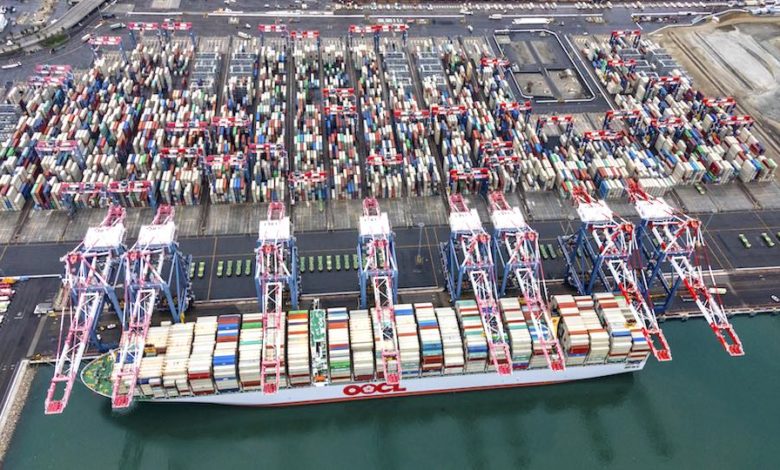Economic concerns cloud liner outlook

The start of the boxes from reopened Shanghai are due to hit the US west coast next week. However, conflicting data points question whether the inbound armada of delayed shipments after the two-month lockdown at China’s largest city is one last hurrah in container shipping’s great bull run.
For the first time in two months, the Port of Los Angeles, America’s premier maritime gateway, expects inbound container volumes will exceed year-earlier levels. Next week, the number of ships expected to offload now stands at 27 ships loaded with 137,000 teu, up 15.1% year-on-year.
“We expect a surge of containers onto the transpacific, leading to higher utilisation of vessels on this route,” commented Christian Roeloffs, CEO of box buying platform Container xChange, going on to highlight the already significant congestion in Los Angeles as well as at other ports such as Houston, where authorities have decided to open the ports gates to trucks on Saturdays for the remainder of the year.
The Washington DC-based National Retail Federation (NRF) released yesterday its monthly forecast for retail import volumes at the US’s container ports.
The NRF said that retail imports in the first six months of 2022 are expected to be up more than 5% year-over-year to a total of 13.5m teu. The NRF is forecasting that June will also be up 7.5% to reach 2.31m teu.
We’re in for a busy summer at the ports
“We’re in for a busy summer at the ports,” claimed NRF vice president for supply chain and customs policy Jonathan Gold. “Back-to-school supplies are already arriving, and holiday merchandise will be right behind them.”
On the horizon, the fractious negotiations with dockworkers at US west coast ports is causing concern.
Labour agreements for longshore services at west coast ports are due to expire in three weeks with a host of retail associations this week urging president Joe Biden to intervene and help bring a resolution to avoid any downed tools during the peak season.
The bigger economic picture is also raising concerns for the health of the liner trades.
On Wednesday, the Organization for Economic Cooperation and Development (OECD) cut its global growth estimates to 3% in 2022, down from its 4.5% estimate.
On Tuesday, the World Bank slashed its 2022 GDP forecast from 4.1% to 2.9%. Also Tuesday, US treasury secretary Janet Yellen said the US economy is likely facing a prolonged period of high inflation.
Meanwhile, Container Trade Statistics (CTS) has released its April demand data, which shows a negative development in volumes.
Looking at the CTS data, Lars Jensen, CEO of liner consultancy Vespucci Maritime, commented: “Global demand in April declined 4.2%, and perhaps more concerning, global volumes are now only 0.9% higher than where they were in April 2019 prior to the pandemic.”
Global volumes are now only 0.9% higher than they were prior to the pandemic
According to Vespucci Maritime’s model for calculating teu*miles, global demand in April was down 5.5% compared to a year ago and is now also down 1.2% compared to April 2019.
The slowdown in volumes on the transpacific is especially noticeable with data from SONAR, a freight forecasting platform developed by FreightWaves, showing that container imports bound for the US have dropped over 36% since May 24. The index measures departing container volumes at the port of origin, suggesting the drop will be felt in the US in early July.
Also turning bearish on prospects has been Niels Rasmussen, BIMCO’s chief shipping analyst, who issued a quarterly shipping markets review this week in which he noted container volumes have shown some early signs of weakening.
As well as Western consumers tightening their belts over the soaring inflation, major US retailers such as Walmart and Target are sitting on inventories of $45bn as of the end of May according to Bloomberg, up 26% from a year ago.
In China, meanwhile, there’s plenty of conflicting data on where liner fortunes are heading.
Analysts reacted with surprise this week on news Chinese exports rose 16.9% year-on-year in May, rebounding from only 3.9% year-on-year in April.
However, full-year figures look less sanguine. After surging 30% in 2021, Chinese exports are likely to grow just 1.6% this year, according to recent analysis from Japanese bank Nomura.
More broadly, analysts say that a shift in supply chains for cheaper manufacturing in Southeast Asia is accelerating after a brief pause in the past two years. About 7% of Chinese orders for furniture were lost to countries like Vietnam between September 2021 and March 2022, as well as 5% for textile products and 2% for electronics, according to an estimate by Everbright Securities.
Drewry’s World Container Index, a global spot freight rate indicator, extended its five-week decline today, dropping nearly $50 to $7,578.65 per feu, still roughly six times higher than the moment the World Health Organization declared covid a pandemic in March 2019, an event that set in place the economic conditions for the greatest boom in container shipping history.
Even if spot rates tumble, liners are on course to post enormous profits, nearing or surpassing last year’s record combined $190bn, thanks to the very high figures signed for long term contracts over the past few months.
May saw the highest monthly increase in long-term contracted ocean freight rates since Oslo-based Xeneta started tracking these shipments, as the cost of locking in container shipments soared by 30.1%.
The unprecedented hike, revealed in the latest Xeneta Shipping Index (XSI) public indices for the contract market, means that long-term rates are now 150.6% up year-on-year.
Average operating margins for the container industry are unprecedented in the history of shipping. Having gone through all Q1 results, the latest data from Alphaliner shows that the leading carriers are now generating a margin of 57.4%, versus an average of just -0.2% in the decade preceding the pandemic.
